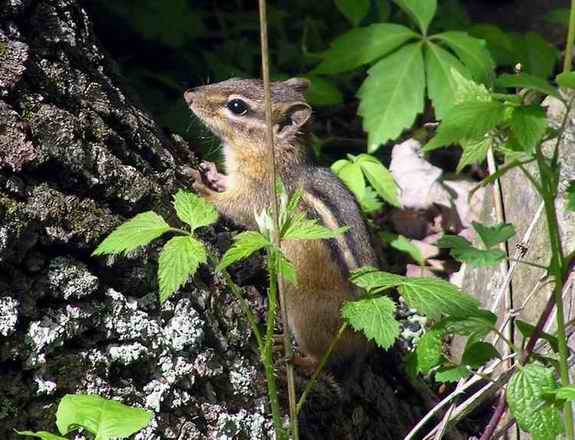|
Return to Hiker's Notebook Home Page
Common Name: Chipmunk - From the Native American Algonquian word atchitamon with the literal meaning "one who descends trees headlong." This became chip-munk in English probably as a combination of the two words "chip" and "mink" the former for the characteristic chip sound, the latter for another furry mammal; thus, the mink that chips. Scientific Name: Tamias striatus - The generic name is Greek for "one who stores things" referring to the chipmunk's hoarding behavior in food gathering; striatus is striped in Latin and reflects the distinctive longitudinal striping of the fur.
The seemingly gregarious and high-spirited chipmunk is established in cultural iconography as the mischievous Chip and Dale or as the sonorous Alvin, Theodore and Simon. In reality, chipmunks are solitary dwellers, defending about 2500 square meters (0.6 acre) around their individual burrows against intruders, including other chipmunks. They do not even form monogamous pairings during the mating season. Females are in estrus for about a week during which time the males compete for mating rights, the victor sometimes ultimately suffering rejection by the female who bites him and chases him from the burrow. The scolding chip-chip is rather suggestive of a harridan.
Chipmunks live in underground tunnels that are about two inches in diameter and up to thirty feet in length. The tunnels are assiduously dug with the sharply clawed front feet and the dirt is pushed to the surface and carried away to conceal the entrance from predators. The depth of the tunnels ranges from two to three feet according to the prevailing winter temperatures. The tunnels are fashioned with several sleeping areas lined with soft leaves and with several food storage areas, normally at the lowest point in the tunnel to keep the provender cool and fresh.
Chipmunks are omnivorous. Their primary diet of nuts, seeds and berries is occasionally augmented by the consumption of fungi, slugs, insects and even small birds and snakes. As the colder and shorter days of fall herald the coming of the winter, chipmunks become consummate foragers, storing nonperishable foodstuffs in their tunneled lairs for midwinter nourishment. The cheek pouches of the chipmunk are capacious and have reportedly contained 31 corn kernels, 70 sunflower seeds, or 32 beech nuts. Experiments with chipmunk foraging revealed that a chipmunk can deliver about 4600 kilojoules (kJ) of food energy to the larder every day. The average 163 kJ energy consumption of an active chipmunk is reduced to 25kJ in the winter torpor. Thus a single day's foraging is enough to sustain the chipmunk for the six months of cold weather.
Chipmunks do not hibernate in the winter; they enter a torpid state called superficial or shallow hibernation. True hibernation occurs when body temperature is lowered near to that of the environment with concomitant physiological changes like a reduction in breathing to about three irregular breaths per minute. Only three orders of mammals display true hibernation: Insectivora like the hedgehog, Chiroptera, the bats, and Rodentia, like the marmot and the ground squirrel. Shallow hibernation is a compromise between full activity and true hibernation, the latter being a precarious mode of survival; a significant number of animals expire. The chipmunk retires to its tunnel nest in the late fall and enters a deep sleep during which time its body temperature is somewhat reduced and its metabolism slowed. About every two weeks, it awakens and snacks on cached food in a somnambulate state and then resumes its long sleep.
Chipmunk populations rise and fall with the availability of nuts and seeds. Accordingly, when oak and hickory trees produce an abundant crop of nuts every three to five years, a phenomenon known as masting, the chipmunk population will rise. This is because the surplus food will improve winter survival rates and reproduction will peak. When a low nut production year follows, the chipmunks die off. The rationale for masting is predator satiation; there will always be more nuts for tree propagation during a mast year since the predator chipmunks are satiated and can not store any more.
The chipmunk is prominent in the legends of the Native Americans. One well-known Iroquois story called "Chipmunk and Bear" anthropomorphizes the former as devil-may-care and the latter as unbearably arrogant. Bear proclaimed he could do anything so Chipmunk challenged him to stop the sun from rising. Bear took the challenge and proclaimed that the sun would not rise the next morning. When the sun rose, Bear was upset and Chipmunk laughed so hard that he collapsed from weakness. Bear pinned Chipmunk to the ground with one big paw, proclaiming "your time to walk the Sky Road has come." Chipmunk asked for one last prayer, beseeching Bear to lift his paw just enough for him to breathe. Bear complied and Chipmunk pulled free, the tips of Bear's claws scraping his back in the process leaving three stripes. Chipmunk retains the stripes to this day as a reminder that one animal never makes fun of another. |
